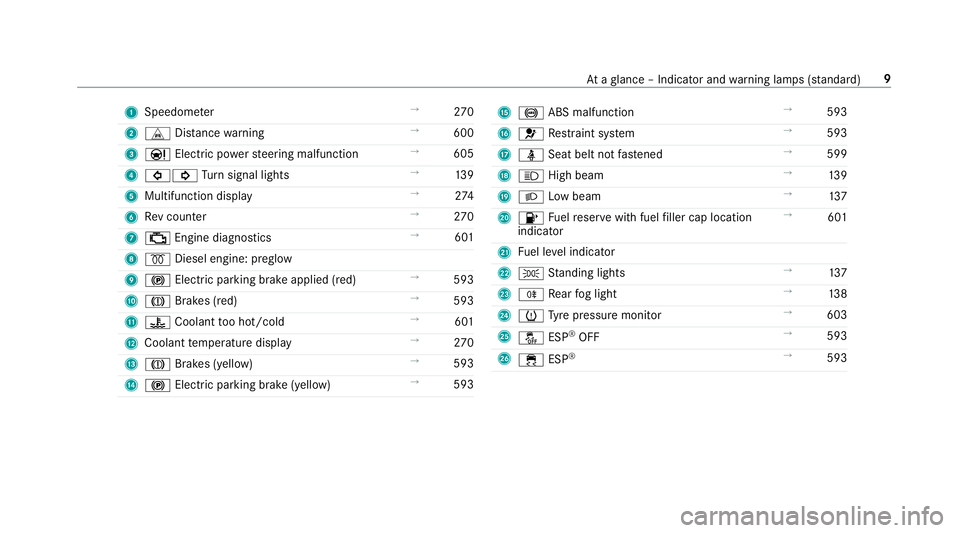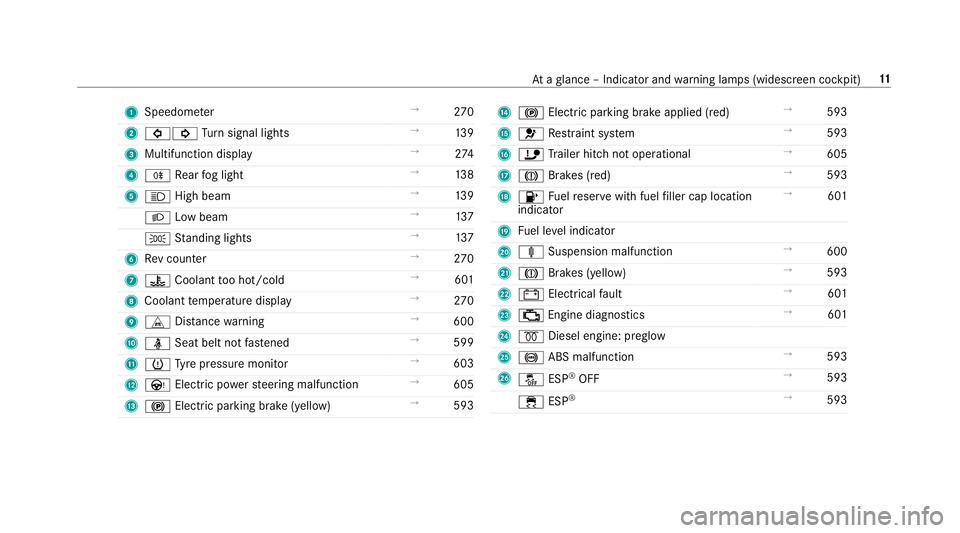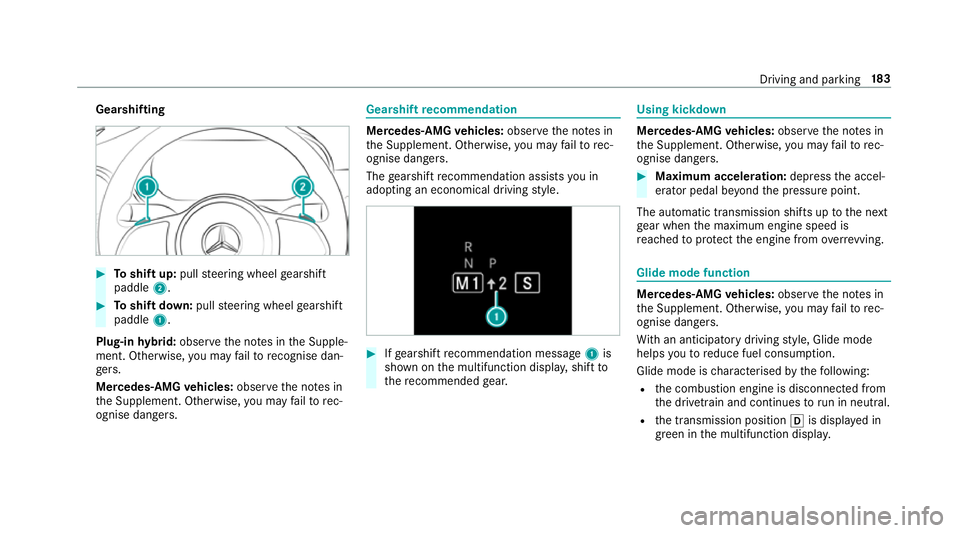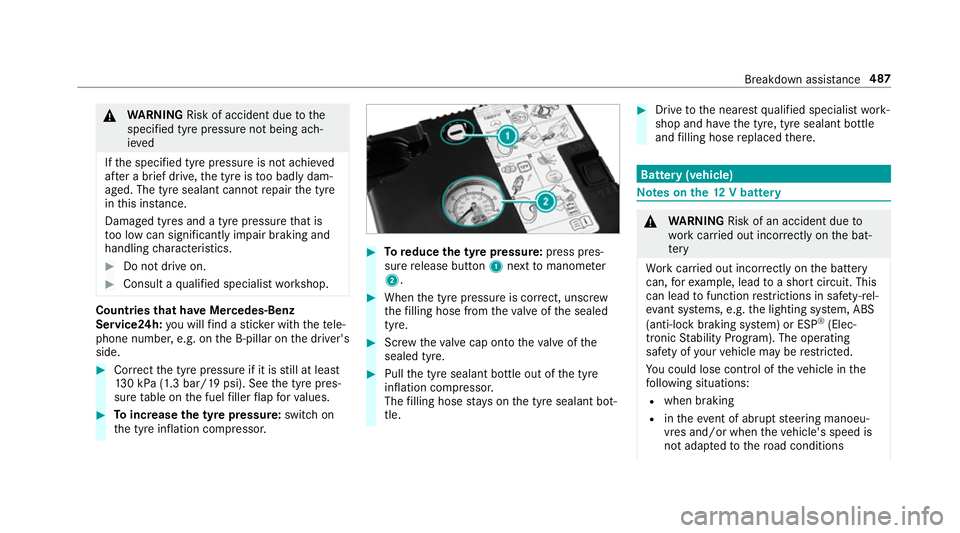2019 MERCEDES-BENZ GLC COUPE fuel pressure
[x] Cancel search: fuel pressurePage 6 of 657

Climate control
........................................ 15 3
Overview of climate contro l systems ..........1 53
Operating the climate control sy stem ......... 154 Driving and pa
rking ................................. 16 5
Driving ........................................................ 16 5
DY NA MIC SELECT switch ............................1 77
Au tomatic transmission .............................. 17 9
Fu nction of the 4MATIC .............................. 184
Re fuelling .................................................... 184
Pa rking ...................................................... .190
Driving and driving saf ety sy stems .............1 99
Tr ailer hit ch................................................ 262
Bicycle rack function .................................. 267
Ve hicle towing instructions ........................ .269 Instrument Display and on-board
comp uter.................................................. 270
Instrument display overview ...................... .270
Overview of the buttons on thesteering
wheel ..........................................................2 71
Operating the on-board computer .............. 272
Setting the design ....................................... 273
Setting the area for additional values .......... 274Overview of displa
yson the multifunc‐
tion display .................................................2 74
Ad justing the instrument lighting ................2 75
Menus and submenus ................................. 275
Head-up Display ......................................... 282 LI
NG UATRONIC ........................................ 284
No tes on operating saf ety .......................... 284
Ope ration ................................................... 285
Using LINGU ATRO NIC ef fectively ................ 287
Essential voice commands ........................ .288 MBUX multimedia sy
stem ...................... 304
Overview and operation .............................. 304
Sy stem settings .......................................... 340
Fit & Healt hy............................................... 349
Na vigation .................................................. 354
Te lephone .................................................. .397
Online and Internet functions ..................... 428
Media ......................................................... 437
Ra dio .......................................................... 445
TV ............................................................... 448
Sound ......................................................... 456 Main
tenance and care ............................. 460
ASS YST PLUS service inter val display ........ 460
Engine compartment .................................. 461
Cleaning and care ...................................... .469 Breakdown assi
stance ............................ 47 9
Emergency ................................................. .479
Flat tyre ...................................................... 481
Battery (vehicle) ......................................... 487
To w- starting or towing away ....................... 493
Electrical fuses ........................................... 498 Wheels and tyres
..................................... 502
No tes on noise or unusual handling char‐
acteristics .................................................. .502
No tes on regular lyinspecting wheels and
tyres .......................................................... .502
No tes on snow chains ................................ 502
Ty re pressure .............................................. 503
Wheel change .............................................. 511
Emergency spare wheel .............................. 520 Contents
3
Page 12 of 657

1
Speedom eter →
270
2 L Distance warning →
600
3 Ð Electric po werst eering malfunction →
605
4 #! Turn signal lights →
13 9
5 Multifunction display →
274
6 Rev counter →
270
7 ; Engine diagnostics →
601
8 % Diesel engine: preglow
9 ! Electric pa rking brake applied (red) →
593
A J Brakes (red) →
593
B ? Coolant too hot/cold →
601
C Coolant temp erature display →
270
D J Brakes (yell ow) →
593
E ! Electric parking brake (yell ow)→
593 F
! ABS malfunction →
593
G 6 Restra int sy stem →
593
H ü Seat belt not fastened →
599
I K High beam →
13 9
J L Low beam →
137
K 8 Fuelreser vewith fuel filler cap location
indicator →
601
L Fuel le vel indicator
M T Standing lights →
137
N R Rear fog light →
13 8
O h Tyre pressure monitor →
603
P å ESP®
OFF →
593
Q ÷ ESP®
→
593 At
aglance – Indicator and warning lamps (s tanda rd) 9
Page 14 of 657

1
Speedom eter →
270
2 #! Turn signal lights →
13 9
3 Multifunction display →
274
4 R Rear fog light →
13 8
5 K High beam →
13 9
L Low beam →
137
T Standing lights →
137
6 Rev counter →
270
7 ? Coolant too hot/cold →
601
8 Coolant temp erature display →
270
9 L Distance warning →
600
A ü Seat belt not fastened →
599
B h Tyre pressure monitor →
603
C Ù Electric po werst eering malfunction →
605
D ! Electric pa rking brake (yellow) →
593 E
! Electric parking brake applied (red) →
593
F 6 Restra int sy stem →
593
G ï Trailer hit chnot operational →
605
H J Brakes (red) →
593
I 8 Fuelreser vewith fuel filler cap location
indicator →
601
J Fuel le vel indicator
K ä Suspension malfunction →
600
L J Brakes (yellow) →
593
M # Electrical fault →
601
N ; Engine diagnostics →
601
O % Diesel engine: preglow
P ! ABS malfunction →
593
Q å ESP®
OFF →
593
÷ ESP®
→
593 At
aglance – Indicator and warning lamps (widesc reen cockpit) 11
Page 22 of 657

Pr
otection of the environment
Plug-in hybrid: obser vethe no tes in the Supple‐
ment. Otherwise, you may failto recognise dan‐
ge rs.
+ ENVIRONMENTAL
NOTEEnvironmental
dama gedue tooperating conditions and
personal driving style The pollutant emission of
your vehicle is
directly related tothewa yyo u operate your
ve hicle.
Help toprotect the environment byoperating
yo ur vehicle in an environmentally responsi‐
ble manner. Please obser vethefo llowing rec‐
ommendations on ope rating conditions and
pe rsonal driving style.
Operating conditions: #
Make sure that the tyre pressure is cor‐
re ct. #
Do not car ryany unnecessary weight
(e.g. roof luggage rack s once you no
lon ger need them). #
Adhere tothe service inter vals.
A regularly serviced vehicle will contri b‐
ute toenvironmen tal pr otection. #
Alw ays ha vemaintenance workcar ried
out at a qualified specialist workshop.
Pe rsonal driving style: #
Do not depress the accelera tor pedal
when starting the engine. #
Do not warm upthe engine while the
ve hicle is stationar y. #
Drive carefully and maintain a suitable
di st ance from theve hicle in front. #
Avoid frequent, sudden acceleration
and braking. #
Change gear in good time and use each
ge ar on lyup toÔ of its maximum
engine speed. #
Switch off the engine in stationary traf‐
fi c, e.g. byusing the ECO start/ stop
function. #
Drive fuel-ef ficiently. Obser vethe ECO
display for a fuel-ef ficient driving style. +
ENVIRONMEN
TALNO TEEnvironmental
pollution caused byirre sponsible dis‐
posal of the high-voltage battery A high-voltage battery conta
ins materials
which are harmful tothe environment. #
Dispose of faulty high-voltage bat teries
at a qualified specialist workshop. Ta
ke -back of end-of-life vehicles
EU countries onl y:
Mercedes-Benz will take back your end-of-life
ve hicle for environment-friendly disposal in
accordance with the European Union(EU) End-
of-Life Vehicles Directive.
A network of vehicle take -ba ckpoints and dis‐
mantlers has been es tablished foryo uto return
yo ur vehicle. You can lea veit at any of these
points free of charge . This makes an impor tant
contribution toclosing there cycling circle and
conse rving resources.
Fo r fur ther information about there cycling and
disposal of end-of-li fevehicles, and theta ke- Gene
ral no tes 19
Page 186 of 657

Gearshifting
#
Toshift up: pullsteering wheel gearshift
paddle 2. #
Toshift down: pullsteering wheel gearshift
paddle 1.
Plug-in hybrid: obser vethe no tes in the Supple‐
ment. Otherwise, you may failto recognise dan‐
ge rs.
Mercedes-AMG vehicles: observeth e no tes in
th e Supplement. Otherwise, you may failto rec‐
ognise dangers. Gearshi
ftrecommendation Mercedes
-AMG vehicles: observeth e no tes in
th e Supplement. Otherwise, you may failto rec‐
ognise dangers.
The gearshift recommendation assists you in
adopting an economical driving style. #
Ifge arshift recommendation message 1is
shown on the multifunction displa y,shift to
th ere commended gear. Using kickd
own Mercedes-AMG
vehicles: observeth e no tes in
th e Supplement. Otherwise, you may failto rec‐
ognise dangers. #
Maximum acceleration: depress the accel‐
erator pedal be yond the pressure point.
The automatic transmission shifts up tothe next
ge ar when the maximum engine speed is
re ached toprotect the engine from overrev ving. Glide mode function
Mercedes-AMG
vehicles: observeth e no tes in
th e Supplement. Otherwise, you may failto rec‐
ognise dangers.
Wi th an anticipatory driving style, Glide mode
helps youto reduce fuel consum ption.
Glide mode is characterised bythefo llowing:
R the combustion engine is disconnected from
th e driv etra in and continues torun in neutral.
R the transmission position his displa yed in
green in the multifunction displa y. Driving and pa
rking 18 3
Page 190 of 657

*
NO
TEFuel may spr ayout when you
re mo vethe fuel pump nozzle. #
Only fill th e fuel tank until the pump
nozzle switches off. Re
quirements:
Plug-in-hybrid: forve hicles with a petrol engine,
obser vethe no tes in the Supplement. Otherwise,
yo u may failto recognise dangers.
R The vehicle is unloc ked (/ page75).
% Do not get into theve hicle again during the
re fuelling process. Otherwise, electros tatic
ch arge could build up again.
Obser vethe no tes on operating fluids
(/ page 526). 1
Fuelfiller flap
2 Brac ketfo rth e fuel filler cap
3 Tyre pressure table
4 QR code forre scue card
5 Fuel type #
Press on the back area of fuel filler flap 1. #
Turn the fuel filler cap anti-clockwise and
re mo veit. #
Insert the fuel filler cap into brac ket2. #
Comp lete ly inse rtthe pump nozzle into the
ta nk filler nec k,hook in place and refuel. #
Only fill th e fuel tank until the pump nozzle
switches off.
% Vehicles with a diesel engine: theta nk
fi ller neck is designed forre fuelling at diesel
fi lling pumps.
% Vehicles with a diesel engine: whenthe
fuel tank is compl etely em pty, top up with at
least 5 litres of diesel.
% Vehicles with a diesel engine: use afiller
neck with a lar gediame terfo rve hicles with
a diesel engine when topping up fuel from a
fuel can. Otherwise, thefiller neck cannot
slide into theta nk. #
Replace the cap on thefiller neck and turn
clockwise until it engages audibl y. #
Close fuel filler flap 1. Driving and parking
187
Page 490 of 657

&
WARNING Risk of accident due tothe
specified tyre pressure not being ach‐
ie ved
If th e specified tyre pressure is not achie ved
af te r a brief drive, the tyre is too badly dam‐
aged. The tyre sealant cannot repair the tyre
in this ins tance.
Dama ged tyres and a tyre pressure that is
to o low can significantly impair braking and
handling characteristics. #
Do not drive on. #
Consult a qualified specialist workshop. Countries
that ha veMercedes-Benz
Service24h: you will find a sticke r with thete le‐
phone number, e.g. on the B‑pillar on the driver's
side. #
Cor rect the tyre pressure if it is still at least
13 0 kPa (1.3 bar/19 psi). See the tyre pres‐
sure table on the fuel filler flap forva lues. #
Toincrease the ty repressure: switch on
th e tyre inflation compressor. #
Toreduce the tyre pressure: press pres‐
su re re lease button 1next tomanome ter
2 . #
When the tyre pressure is cor rect, unscr ew
th efilling hose from theva lve of the sealed
tyre. #
Screw theva lve cap onto theva lve of the
sealed tyre. #
Pull the tyre sealant bottle out of the tyre
inflation compressor.
The filling hose stay s on the tyre sealant bot‐
tle. #
Drive tothe nearest qualified specialist work‐
shop and ha vethe tyre, tyre sealant bottle
and filling hose replaced there. Batte
ry(vehicle) Note
s onthe12 V battery &
WARNING Risk of an accident due to
wo rkcar ried out incor rectly on the bat‐
te ry
Wo rkcar ried out incor rectly on the battery
can, forex ample, lead toa short circuit. This
can lead tofunction restrictions in saf ety-re l‐
eva nt sy stems, e.g. the lighting sy stem, ABS
(anti-lock braking sy stem) or ESP ®
(Elec‐
tronic Stability Prog ram). The operating
saf ety of your vehicle may be restricted.
Yo u could lose cont rol of theve hicle in the
fo llowing situations:
R when braking
R intheeve nt of ab rupt steering manoeu‐
vres and/or when theve hicle's speed is
not adap tedto thero ad conditions Breakdown assis
tance 487
Page 507 of 657

#
Ifyo u are unable torectify the damage,
conta ct aqualified specialist workshop. Information on
there commended tyre pressure
fo rth eve hicle's factor y-fitted tyres can be found
on the tyre pressure table on the inside of the
fuel filler flap (/ page 504).
Use a suitable pressure gauge tocheck the tyre
pressure. The outer appearance of a tyre does
not permit any reliable conclusion about the tyre
pressure.
Ve hicles with a tyre pressure monitoring sys‐
te m: you can also check the tyre pressure using
th e on-board computer.
Only cor rect tyre pressures when the tyres are
cold. Conditions for cold tyres:
R The vehicle has been par ked with the tyres
out of direct sunlight for at least thre e hours.
R The vehicle has tr avelled less than 1.6 km.
A rise in the tyre temp erature of 10°C increases
th e tyre pressure byappr ox.10 kPa (0.1 bar/
1. 5 psi). Take this into account when checking
th e tyre pressure of warm tyres. Tr
ailer operation no tes
Alw ays inflate there ar axle tyres tothere com‐
mended tyre pressures on the tyre pressure
ta ble for increased load. Ty
re pressure table The tyre pressure
table is on the inside of the
fuel filler flap. The tyre pressure
table sho ws there commended
tyre pressure for all tyres appro vedfo rth is vehi‐
cle. The recommended tyre pressures apply for
cold tyres under various operating conditions,
i.e. loading and/or speed of theve hicle.
If one or more tyre sizes precede a tyre pres‐
sure, the tyre pressure information following is
only valid forth ose tyre sizes.
If th e preceding tyre sizes are complemented by
th e+ symbol, the tyre pressure information
fo llowing sho wsalternative tyre pressures.
These tyre pressures may impr oveyour vehicle's
ri de comfort. Fuel consum ption may then
increase slightl y.
The load conditions "partially laden" and "fully
laden" are defined in theta ble for dif fere nt num‐
be rs of passengers and amounts of luggage. The
actual number of seats may dif fer from this.
Be sure toalso obse rveth efo llowing fur ther
re lated subjects:
R Notes on tyre pressure (/ page 503)504
Wheels and tyres